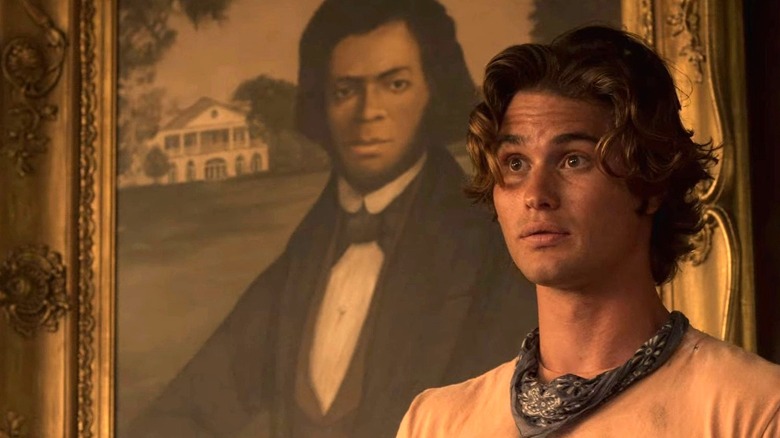Who Owns The Gold In Outer Banks Season 3? The True Story Behind Denmark Tanny
Behind every great treasure hunt (real or fictional) is some figure of mythic proportions, be it One-Eyed Willy or Captain Kidd. In Netflix's "Outer Banks," that figure is Denmark Tanny, who made his debut via a 19th-century portrait in Season 1, Episode 4. Tanny is the founder and namesake of the Tannyhill Plantation, and his mystique extends back to the Royal Merchant shipwreck. Tanny, an enslaved person, was a cook on the ill-fated ship — and also its sole survivor.
Following the wreck, Tanny managed to salvage all of the treasure on board, including the Cross of Santo Domingo. He used some of the fortune to purchase his own freedom, the freedom of the enslaved people on Kildare Island, and the plantation. After procuring the freedom of his three sons, he attempted to do the same for his wife and daughter. However, the Limbreys, the surviving family of the Royal Merchant's Captain Herman Limbrey, murdered Tanny's wife, daughter, and Tanny himself.
Though he was lynched in 1844, Tanny casts a large shadow over the events of "Outer Banks" as the enigmatic owner of the Royal Merchant fortune. His backstory is so vivid, it's of little surprise that he is, in part, based on a real person: Denmark Vesey.
Though "Outer Banks" is named for its North Carolina locale, much of the series was filmed in Charleston, South Carolina, with some pivotal scenes taking place there as well. By including this nod to the city of Charleston, the show pays homage to Vesey, as he lived there, planned an insurrection, and is commemorated today with a monument.
Denmark Vesey served as inspiration for Denmark Tanny
Born into slavery in roughly 1767 in St. Thomas, Denmark Vesey was sold to Carolina slave trader Captain John Vesey, who took Denmark to Charleston. In 1799, Vesey won the lottery and purchased his freedom for $600, after which he worked as a successful carpenter. Like Denmark Tanny, Vesey attempted but was ultimately unable to purchase the freedom of his wife and children.
Vesey is best known for leading a thwarted slave rebellion in 1822. Scheduled to happen on the anniversary of the French Revolution, Vesey's uprising involved the liberation of thousands of slaves, who would then flee to Haiti. The plans were leaked to the authorities, and news of the attempted revolt spread across the young nation and even to Europe. As a result, Vesey and 34 others were tried and publicly executed. Emanuel Church, a Black spiritual center where Vesey was a leader, was burned down, and other instances of anti-Black violence and legislation followed.
Vesey's legacy has stood the test of time. Douglas Egerton and Robert Paquette's 2017 book, "The Denmark Vesey Affair: A Documentary History," aimed to illuminate the attempted rebellion and those involved. In 2014, a monument to Vesey was erected after nearly 20 years of community efforts.
The real-life Vesey may be a far cry from his analog on "Outer Banks," but the series tips its cap to the historic Charleston figure. With "Outer Banks" Season 4 on the horizon, the series will hopefully delve even deeper into Tanny's legacy as an ancestor to Pope (Jonathan Daviss).

